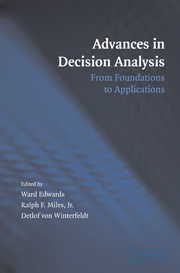Book contents
- Frontmatter
- Contents
- List of Contributors
- Preface
- 1 Introduction
- PART I HISTORY AND FOUNDATIONS OF DECISION ANALYSIS
- PART II STRUCTURING DECISION PROBLEMS
- PART III PROBABILITIES AND BAYES NETS
- PART IV UTILITIES
- PART V RISK ANALYSIS
- PART VI DECISION ANALYSIS IN A BEHAVIORAL AND ORGANIZATIONAL CONTEXT
- PART VII APPLICATIONS OF DECISION ANALYSIS
- Index
- References
Preface
Published online by Cambridge University Press: 05 June 2012
- Frontmatter
- Contents
- List of Contributors
- Preface
- 1 Introduction
- PART I HISTORY AND FOUNDATIONS OF DECISION ANALYSIS
- PART II STRUCTURING DECISION PROBLEMS
- PART III PROBABILITIES AND BAYES NETS
- PART IV UTILITIES
- PART V RISK ANALYSIS
- PART VI DECISION ANALYSIS IN A BEHAVIORAL AND ORGANIZATIONAL CONTEXT
- PART VII APPLICATIONS OF DECISION ANALYSIS
- Index
- References
Summary
Decision analysis consists of models and tools to improve decision making. It is especially useful when decisions have multiple conflicting objectives and when their consequences are uncertain. The theoretical foundations of decision analysis can be found in the three areas of decision theory: individual decision theory, social choice theory, and game theory. In addition, disciplines including the behavioral sciences, economics, operations research, philosophy of science, and statistics have contributed to the foundations of decision analysis.
Several introductory decision analysis texts have been written since Raiffa's Decision Analysis (1968); including Bell and Schleifer (1995); Brown (2005); Brown, Kahr, and Peterson (1974); Clemen (1996); Keeney and Raiffa (1976); Kirkwood (1997); Skinner (1999); von Winterfeldt and Edwards (1986); Watson and Buede (1987); and Winkler (2003). Nevertheless, none of these books cover all of the recent developments in decision analysis. These developments include advances in risk analysis, the use of Bayesian networks and influence diagrams, analysis with multiple stakeholders, generalizations of the expected utility model, and much more. The purpose of this book is to fill this gap with the present state of the art of decision analysis.
This book is intended for two audiences: (1) students who are taking a second course in decision analysis, following an introductory course using any of the texts listed above; and (2) decision analysts or managers who are already familiar with the subject and wish to know the present state of the art.
- Type
- Chapter
- Information
- Advances in Decision AnalysisFrom Foundations to Applications, pp. xi - xviPublisher: Cambridge University PressPrint publication year: 2007



